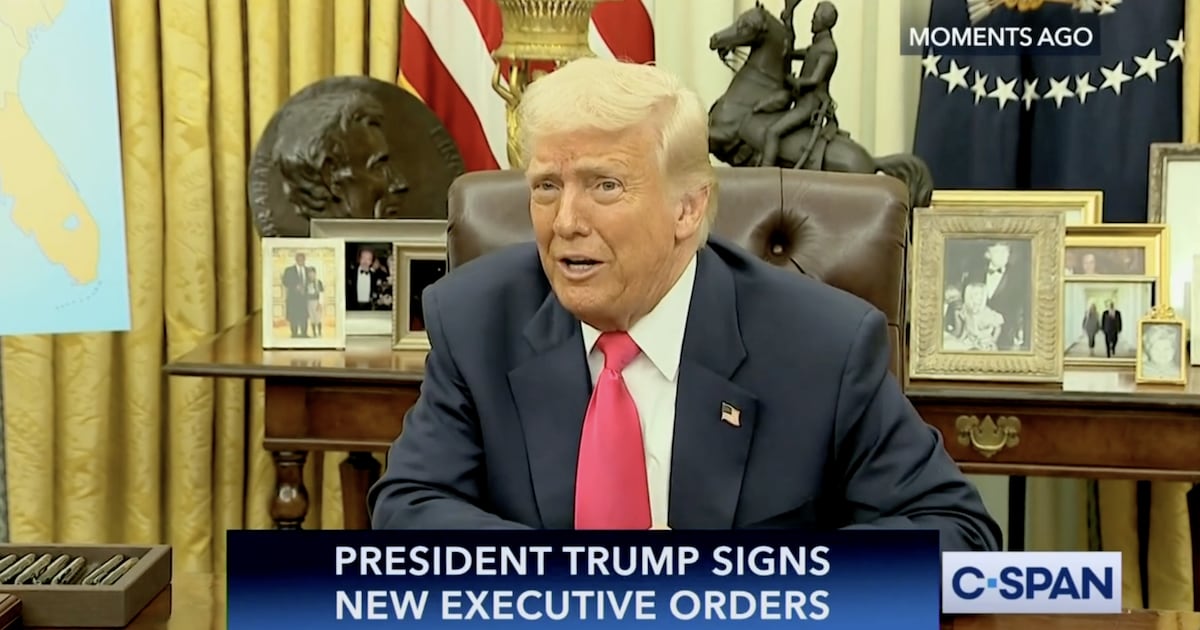Weeks ahead of the largest mass government mailing operation since the AIDS epidemic, some testing authorities, epidemiologists, and public health experts are expressing concern that the beleaguered U.S. Postal Service may struggle to successfully deliver half a billion working tests to Americans who order them.
“Putting it in the hands of the postal service is a risk,” said Lawrence Gostin, director of the O’Neill Institute for National and Global Health Law at Georgetown Law Center, who bluntly told The Daily Beast that the mail carrier is “just ill-equipped” to deal with sensitive pharmaceutical tests on a mass scale.
“This is not like we’re sending Christmas cards and it doesn’t matter if it gets damaged or is late or what the temperature is,” Gostin said. “These are essential medical technologies.”
By the end of January, the U.S. Postal Service is expected to begin shipment of the first wave of one billion at-home COVID tests—doubled from an initial 500 million announced last month—to every American household that requests one from an as-yet-unbuilt government website. The Biden administration, which faced criticism for initially balking at the idea during a nationwide testing shortage, has called the program a critical tool to get more tests in the hands of Americans, many of whom have struggled to source tests amidst the tsunami of COVID-19 cases due to the Omicron variant.
“It’s vitally important that when this website goes up and people are ordering, that they actually get what they order,” said White House press secretary Jen Psaki during a briefing on Wednesday, adding that the government was “exactly on track” for delivery of the first tests by the end of the month. “That’s what we’ve been working on.”
On Thursday morning, President Joe Biden announced that the government had doubled its order of at-home tests to one billion, which will begin to be distributed within days.
“We’re on track to roll out a website next week where you can order free tests shipped to your home,” Biden said before a meeting with his COVID-19 response team. “Today I’m directing my team to procure an additional 500 million more tests to distribute for free—that means a billion tests in total to meet future demand.”
But the postal system—chronically underfunded, understaffed, and under congressional pressure to cut costs even further—faces potential logistical challenges ahead of the campaign. Recent slowdowns in mail service under the direction of Postmaster General Louis DeJoy, too, have raised questions in public health circles about whether the USPS is ready for half a billion parcels to be sent through the mail, particularly given their sensitivity to the elements.
“Freezing then thawing is rarely good for many biological reagents… and is certainly possible in some parts of the country at the moment,” said John P. Moore, a professor of microbiology and immunology at Weill Cornell Medical College, who said that the potential for extreme weather to affect testing accuracy is nearly as much a concern as the ability to get tests mailed on schedule. “Likewise, reagents degrade if the temperature is too high. I don’t know for how long the kits are stable even in the recommended temperature range. One mailed in September and arriving in January wouldn’t give me a lot of confidence.”
Those worries aren’t unfounded. The postal system has been hit hard by worker shortages as thousands of mail carriers have called out sick during the Omicron wave, which has compounded years of cutbacks on delivery speed and accuracy. While USPS this year largely avoided a repeat of the 2020 holiday season’s delivery gridlock with the help of tens of thousands of seasonal workers, the service itself has raised the possibility that Omicron could potentially blow up the postal system. Other private carriers, including UPS and FedEx, have grappled with similar problems, but have benefited from superior tracking systems and smaller-by-comparison scale of domestic distribution.
Earlier this month, USPS sent a letter to the Department of Labor’s Occupational Safety and Health Administration requesting a 120-day reprieve from the Biden administration’s vaccine and testing mandate for government employees, citing the potential for “catastrophic impact” on the mail system if enacted.
Deputy Postmaster Doug Tulino told OSHA in the letter that even outside of its busiest season, USPS would find it “nearly impossible” to meet the deadline imposed by the Biden administration.
“Simply put, the Postal Service does not currently have adequate resources to meet the current ETS deadlines—especially during peak season,” Tulino wrote, adding that the policy, which is currently under review by the U.S. Supreme Court, “is likely to result in the loss of many employees.”
That “catastrophic impact,” combined with recent changes to first-class mail delivery that have slowed mail delivery to its most lethargic pace since the 1970s, could pose a major problem to testing access, said Gostin.
“You do have problems of making sure that the testing kits remain of high quality while getting into people’s homes,” Gostin said. “The postal service is not well equipped to ensure that their mail, at all times, is at a certain temperature and humidity range. That’s not what their mission is.”
Even if tests do reach Americans on time and in working order, O’Connor said, the U.S. government is missing a major component of home testing, which is creating a reporting system for those who test positive in order to track the virus’ spread.
“A significant issue with home testing, which is something that I have advocated for a long time, is making sure the results are reportable even if some choose not to report their data. In Australia, it is mandatory that people report the results of their rapid antigen tests,” O’Connor said. “What sort of policies are going to be put into place so that local health departments know how many of these 500 million tests are being used in their community, how frequently they are positive, and who is testing positive?”
The COVID-related mailing issues, combined with pullbacks in service during an unprecedented surge in applications for mail-in ballots during the 2020 elections, have angered Democrats in recent years, many of whom have pushed President Joe Biden to fire DeJoy. (DeJoy, for his part, has taunted congressional Democrats that they are “stuck with me” for the foreseeable future.)
The administration, meanwhile, has placed full confidence in USPS’s ability to send the tests, along with designating Dr. Tom Inglesby, an epidemiologist and director of the Johns Hopkins Center for Health Security at the Johns Hopkins Bloomberg School of Public Health, as the president’s testing coordinator ahead of the rollout.
“The Postal Service also delivered 98, 99 percent of packages on time in advance of Christmas, and their leaders have also said they’re eager to take on this challenge,” Psaki told reporters on Monday. “So we welcome that, and we’re looking forward to working with them to get these tests out to the public.”
But testing experts aren’t so sure, particularly as a crush of positive cases—more than 1.5 million on Monday, the highest of the pandemic—have made tests a critical part of the health infrastructure.
“It is a concern, as people put a lot of stock in test results, and we want the tests to be as accurate of their health status as possible,” said Dr. Gigi Gronvall, an immunologist and associate professor at the Johns Hopkins Bloomberg School of Public Health. “I guess my question would be, how do we know that they have been stored correctly, at the present time?”
The U.S. Postal Service has been recruited into the fight against a deadly pandemic before. In 1988, the U.S. Public Health Service sent out “Understanding AIDS,” a pamphlet with rudimentary information about HIV/AIDS to nearly 130 million American households, then the largest mass mailing in the country’s history. The billion tests proposed by the Biden administration would far outstrip that record—but would still fall short of scuttled plans under the Trump administration to distribute 650 million cloth masks to every household in America.
That plan was canceled at the last minute by President Donald Trump, who felt that sending the masks “might create concern or panic.”
But beyond the issue of timeliness—most at-home tests were granted an emergency use authorization by the Food and Drug Administration last year, with the most popular having a shelf life of 12 months under optimal conditions—a major concern is the lack of condition control in the shipping and handling process for sensitive scientific tests. Abbott Laboratories, which produces the popular BinaxNOW COVID-19 Antigen Self Test, says that its tests must be stored at temperatures between 35.6° and 86° Fahrenheit, and shouldn’t even be performed unless all components are at room temperature.
“Besides keeping them in cold cars while moving them around, we don’t have any experience testing in extreme cold or extreme heat,” said Dave O’Connor, a professor of pathology and laboratory medicine at the University of Wisconsin. “My guess—but it is purely a guess—is that freezing of the liquid could cause performance issues if it thaws and isn’t mixed thoroughly.”
“Don’t use rapid tests when it’s really cold—that can diminish their benefit or their efficacy,” said Dr. Michael Mina, chief science officer of diagnostics company eMed, on a call with reporters last month. “You want to do it at room temperature for the most part.”
Nearly every step of the delivery process—air, ground, even mailboxes at the end of a driveway—will have variable temperatures and humidity levels, which could screw up sensitive scientific equipment.
“Abbott themselves have even put out warnings regarding storage conditions, and indeed this goes against that,” said Anne Wyllie, a microbiologist at the Yale School of Public Health. “But perhaps they're overlooking this now they stand to have so many orders?”
Gronvall told The Daily Beast that it is possible that the stated range in temperature could be a hedge, rather than a hard-and-fast rule—meaning that a long day in a hot truck might not automatically mean that your mail-in test is skunked.
“There is always the possibility that the test manufacturers have (or could embark on getting) data that suggest that a broader temperature range is okay,” said Gronvall. “I suspect that it is, and that the tests have perhaps already been at more extreme temperatures already, and not stored in ideal conditions, and they have likely worked fine.”
A spokesperson for Abbott Laboratories told The Daily Beast that while tests should be kept within the prescribed range, if the test is stored outside the temperature range “for a relatively short period of time—for a couple of hours up to a day or two—it will be fine to use” once the components reach room temperature again.
As the Northeast endures a brutal cold snap ahead of a major winter storm, USPS did not directly respond to questions about potential risks to test quality in the postal system due to climate control or lack thereof in the shipping process, telling The Daily Beast only that the service is “is proud to fulfill its mission of service to the nation by delivering Covid test kits.”
“The 650,000 women and men of the United States Postal Service are ready to deliver and proud to play a critical role in supporting the health needs of the American public,” USPS said in a statement attributed to DeJoy. “We have been working closely with the administration and are well prepared to accept and deliver test kits on the first day the program launches.”
A postal worker at the New Preston-Marble Dale Post Office in Litchfield County, Connecticut—where the high on Tuesday was a balmy 12° Fahrenheit—was slightly more helpful, telling The Daily Beast that indoor government facilities are generally required to maintain temperatures in the safe range.
The trucks, however, aren’t known for being consistently “cozy,” as the postal worker put it, adding that for any shipment with temperature constraints, “if you had something like that, I would definitely mark that on the box.”





